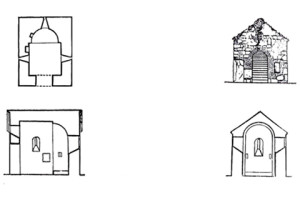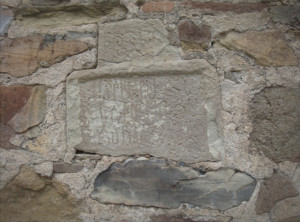Tsavkisi is located in Didgori region of Tbilisi, on the slope of the south-eastern branch of Trialeti ridge, at the height of 900 m above sea level [Gigineishvili, 1987: 285]. According to the data of 2002 Tsavkisi is inhabited by 1199 permanent residents. [Georgian…2003:203]
The first mentioning of Tsavkisi in historical sources is found in the sacrifices book in Svetitskhoveli, when King Alexander renewed his sacrifices to Svetitskhoveli with “makhraghaja and khekordzi” [Materials, 1964:257; Chronicles, 1897: 195]. As is seen Svetitskhoveli had lost its influence because of Ottoman domination in Kartli. Later, in 1595 king Svimon (1556-1600) sacrificed Tsavkisi to Metekhi church. However, on May 7, 1677 Prince Levan and Giorgi renewed it again to Svetitskhoveli and sacrificed [Materials,1964: 257; Kakabadze,1913:53-54].
The mother of King Rostom (1633-1658) was from the village of Tsavkisi [Beri Egnatashvili, 1959].
From historical documents it is known that, Tsavkisi was a part of Satsitsiano [1]. According to the Census of 1721 the landlords of Tsavkisi were Vakhtang V Shahnavaz’s (1658-1675) „Darbaiseli” Utrut Tsitsishvili, Papuna Tsitsishvili (Sardlishvili) and Zaza Tsitsishvili ( Sardlishvili). [Census…1907].
According to the Census book of 1781 village population of Tiflis environs the Tsavkisi landlords were Givi and Teimuraz Tsitsishvili. Tsavkisi was the land of Tsitsishvili residing below, that is why the migration of population to Tsavkisi often occurred from other villages of Lower Tsitsishvili (Nichbisi, Kintsvisi, Kvenaplazi, etc) [Tiflisi …1967:165].
From the 18th century as a result of weakening the Tsitsishvili-s power a part of their lands passed into the hands of Melik Mamasakhlisi-s, Bebutashvili-s[2]. In the Censor book conducted by Ioane Batonishvili at the beginning of the 19th century on the charts of the villages located the south of Tiflis “the town of Tsavkisi” is mentioned [Ioane Bagrationi, 1986:46]. In 1801 an act of the son of king Giorgi XII about Prince David`s serfs who were passed to the state treasury was issued. These serfs appeared to be taken by David for the landlord Givi Tsitsishvili. [ACAC, 1886: 302].
According to the censor conducted by the Russian Empire in 1804 Tsavkisi covered 302 dessiatina[3]which is inhabited by only 10 peasant households; the landlords are Pharsadan, Zaza and Utrud Tsitsishivili-s [CHAG, case. 74: 43]. The process of taking off the serfs and their transfer to the State Treasury just started at that time. By all data the number of population must have been more. The possibility of making an error while recording the population of Tsavkisi was easy as it is known that in 1781 there lived 16 households [Tiflis…1967: 165] and in 1817 – 27 households [CHAG, case. 477:27-28] . In the middle period the existence of only 9 households gives rise to doubt. At the same time it is not doubtful among the landlords the nobleman Babutashvili does not seem doubtful. It is known that by that time in the villages of Tbilisi environs – Tskneti and Tsavkisi, the lands of Tsitsishvili-s already belonged if not totally their great part to the Babutashili-s. Presumably, the landlords with the aim of reducing the taxes hid their serfs intentionally.
There are several churches in Tsavkisi which are mainly built in the late middle ages. The monument we are interested in is located in the cemetery. It is a small basilica church with tall sanctuary; has the porch from the west side. The church is built of stones. Georgian red brick was used in the construction. At the porch on both sides there were installed “khachkari”[4] of which the left one, the bigger is grey and the right one the small is brown. During the restoration conducted at the end of the 20th century the stone crosses from the Tsavkisi church were taken off and currently they are placed inside the church.
Figure 1.
Tsavkisi church, the view from the south-east.
In the southern wall a small grey stone is inserted with Armenian inscription performed in five line capital letters.
Figure 2.
Plan and section of the Tsavkisi church.
Figure 3.
Tsavkisi church, southern wall, Armenian inscription
Ի ԹՎԻՆ ՋԽԲ
ԵՍ Տ–Ր ԱԻԷՏԻՍ Ք–ՀՆԱՍ
ՇԻՆԵՑԻ Ս–Ի ԵԿՂՑԻՍ
Տ–Ր Յ–Ս ԸՆԿԱԼ ՁԵՌԱՑ
ԻՄՈՑ
The “construction” inscription is translated into Georgian as: In the year of 942 [+551+1493] I, Father Avetis priest, built this church. ‘Lord Jesus Christ, Son of God, please accept from my hands”[5].
The inscription was read by Professor Leon Meliksed-Beg and he stated without doubt that this church was built by an Armenian priest Terter in 1493 [Leon Melikset-Beg, 1922: 100]. This view is shared by the majority of the scholars [Schmerling…1960: 67; Karapetyan, 1995].
Nothing is said about the inscription by Professor Paruir Muradyan in his well known work “Armenian Epigraphics of Georgia” [Muradyan, 1985].
Generally in Armenian historiography a purposive tendency of belongness of Georgian churches to the Armenian is taking shape. In 1995 Samvel Karapetyan’s book “Armenian churches in Georgia” [Karapetyan, 1995] appeared in Armenia. The map directory deals with the Armenian background of around 650 churches. Georgian historian Professor Bondo Arveladze considers in details the map-directory and makes an assumption about Tsavkisi church inscription that it must have been brought later [Arveladze,996:36].
Due to some reasons we cannot share the supposition of the Armenian scholars as if the Tsavkisi church was built by priest Terter in 1493. As was mentioned above Tsavkisi together with neighboring Shindisi was registered in Mtskheta church lands since the 14th century (probably even earlier, because in the charter of donation it is said about renovation). At the same time it was less included in the process of “Armenization” or Armenian settlement. Moreover, we can boldly state that unlike the neighboring villages Tsavkisi is the only village where the presence of Armenians is not traced till the 80-90s of the 18th century (until the lands of the nobleman Tsitsishvili gradually fell into Tbilisi Melik Mamasakhlisi-s or of Armenian background landlord Babutashvili-s hands). Babutashvili tried hard the “armenization”[6] of Tsavkisi and other villages. However, after the establishment of the Russian administration in 1804, census Tsavkisi is still named as totally Georgian village. [ACAC, 1886: 461].
A question arises as to how the inscription and “khachkar” appeared in Georgian village of Tsavkisi.
It is a known fact that while migrating, the Armenians often take construction inscriptions from their sanctuaries, “stone crosses” and toponyms too. We can boldly state this on the example of today’s Javakheti region.
The similar stone on which Armenian inscription was done, cannot be found locally and is not used in the construction of the church at all. It is noteworthy that there is no mentioning of either king or feudal (even Armenian) on this construction inscription, or when this inscription was done; the toponym Tsavkisiis not mentioned. All these facts cast doubt on and make us think that this inscription if it was not falsified later and really was done in 1493 must have been appeared in Tsavkisi at the end of the 18thcentury. It seems several households were settled in Tsavkisi with intention of “Armenization” in the 18th century and the migrants install in the wall of Georgian church the inscription and stone cross brought with them. However, as is seen they failed to settle there for along time and changed their residence again but their trace appeared to be left in the form of inscription and stone cross.
Thus, we can conclude that the inscription done in Armenian language in cemetery church of Tsavkisi was inserted later and there is no ground to claim that this is an Armenian church.
[1] Satsitsiano – princehood of Tsitsishvili. The Tsitsishvilis were moved from Samtskhe. They were the owners of Phanaskerteli fortress in Tao. Due to the controversy with Atabeg Kvarkvare II (1451-1498) Zaza Phanaskerteli moved to Kartli. In the gorge of the river Dzama he founded the princedom. The Tsitsishvilis belonged to a big family numbers until they were divided into the Upper and Lower branches. Tsavkisi belonged to the Lower Tsitsishvili Family. The Tsitsishvilis were king’s commanders during the war. King’s flag army was gathered from Satsitsiano villages.
[2] The Babutashvili-s came into prominence in the 17th century when the king Rostom (1633-1658) granted to Khoja Bebuta lands in Tbilisi and position. After this Bebuta’s children gradually advanced though they did not have feudal organization – satavado like other patrimonial. Before the establishment of the Russian administration (1801) they occupied the post of Tbilisi Melik or Melik-Mamasakhlisi.
[3] Dessiatina – measure of land in old Russia, took effect before the introduction of metric system. One dessiatina equals 2400 sq. meters or 1.09 hectares).
[4] Khachkari (Arm. Խաչքար means stone cross) is characteristic for Armenian architecture. A cross and carving are represented on the stele. The stone crosses are spread all over territory of Armenia: on the roads, on the churches. When changing the residing place the stone crosses are transferred to new residence.
[5] Armenian inscription and Georgian translation are given according to the professor Leon Meliksed-Beg [see, Meliksed-Beg, 1922: 100].
[6] For example, it was Tbilisi`s Melik Mamasakhlisi, landowner Darchia the son of Avetik Bebutashvili (1795-1801) who contributed much to the “Armenization” of the village Tskneti. After him this was continued by his servants.
References
|
Arveladze B. |
Are there “Armenian” or Gerogian churches in Georgia? Tbilisi (in Georgian). |
|
Census… |
Materials of statistical description in the 18th century. Published by E.Takaishvili. Tbilisi, (in Georgian). |
|
Beri Egnatashvili |
The Life of Kartli. Text prepared by Simon Kaukhchishvili. Vol. II. Tbilisi, (in Georgian). |
|
Gigineishvili G. |
Tsavkisi. Gerogian Soviet Encsyclopedia. Vol. XI. Tbilisi, (in Georgian). |
|
Ioane Bagrationi |
Census of Kartli and Kakheti. Text prepared for publication and supplied with index by T.Enukidze and G.Bedoshvili. Tbilisi, (in Georgian). |
|
Kakabadze S. |
Historical Documents. IV. Tbilisi, (in Georgian). |
|
Materials… |
Materials of Georgian historical geography and toponyms. Book I (according to the 10th and 17th centuries documents). Prepared for publication by Z.Aleksidze and Sh.Burjanadze. Tbilisi, (in Georgian). |
|
Melikset-Beg L. |
Armenian artifacts in Tiflis environs, Shavnabad-Telet-Tsavkisi// Bulletin of Gerogian Museum №1. Tiflis, (in Georgian). |
|
Georgian… |
Main results of the first national general census of 2002 (rural population), vol.II. Tbilisi, (in Georgian). |
|
Tiflisi… |
The census book of 1781of village around Tiflisi//I.Javakhishvili. Monuments of Georgia’s economic history. Book I. Demographic monuments, the census books of the 18th century eastern Georgia. Tbilisi,(in Georgian). |
|
Chronicles… |
Chronicles and other materials of Gerogian history and writing. Collected, chronologically arranged and explained by T. Zhordania. Vol.II. Tbilisi, (in Georgian). |
|
Karapetyan S. |
„Armenian churches in Georgia“. Erevan. (in Armenian). |
|
ACAC |
Acts collected by Caucassian Archeographical Commision. Published under the editorship of Ad.Berzhe (ACAC), Vol I, Tiflis. (in Russian). |
|
Muradyan P. |
Armenian Epigraphics of Georgia, Kartli and Kakheti. Erevan,(in Russian). |
|
Schmerling … |
Schmerling R., Dolidze V., Barnaveli T. Tbilisi environs. Tbilisi, (in Russian). |
|
CHAG |
Central Historical Archive of Georgia, Fund №254, rec. №1, case № 74. |
|
CHAG |
Central Historical Archive of Georgia, Fund №254, rec №1, case №477. |













 Inauguration ceremony of President of Azerbaijan Ilham Aliyev was held
Inauguration ceremony of President of Azerbaijan Ilham Aliyev was held Ilham Aliyev wins presidential election with 92.05 percent of votes VIDEO
Ilham Aliyev wins presidential election with 92.05 percent of votes VIDEO President Ilham Aliyev, First Lady Mehriban Aliyeva and family members voted in Khankendi VIDEO
President Ilham Aliyev, First Lady Mehriban Aliyeva and family members voted in Khankendi VIDEO Plenary session of 6th Summit of Conference on Interaction and Confidence Building Measures in Asia gets underway in Astana. President Ilham Aliyev attends the plenary session VIDEO
Plenary session of 6th Summit of Conference on Interaction and Confidence Building Measures in Asia gets underway in Astana. President Ilham Aliyev attends the plenary session VIDEO President Ilham Aliyev was interviewed by Azerbaijani TV channels in Prague VIDEO
President Ilham Aliyev was interviewed by Azerbaijani TV channels in Prague VIDEO














